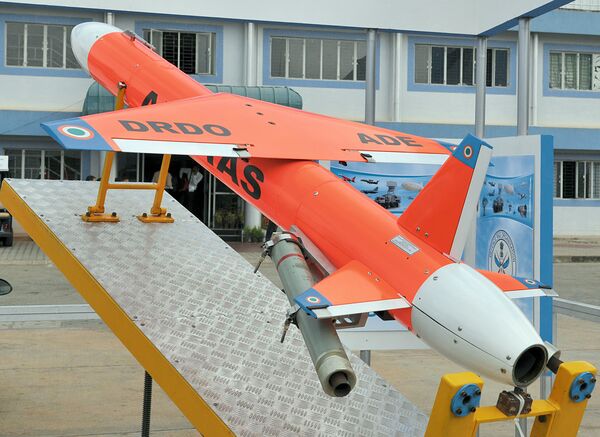SOURCE: AFI

Indian Army issued a Request for Information (RFI) for the procurement of Nano Drones, marking a strategic move to enhance its intelligence, surveillance, and reconnaissance (ISR) capabilities. These drones, weighing a mere 250 grams, are specified to have an operational range of 2 kilometers and an endurance of 30 minutes, making them ideal for tactical missions in challenging environments.
The RFI aligns with the Army’s ongoing efforts to modernize its arsenal under the “Buy (Indian)” category, emphasizing indigenous development as part of the “Atmanirbhar Bharat” initiative. The lightweight drones are expected to support special missions, including counter-insurgency, counter-terrorism, and border security operations along the Line of Control (LoC) and Line of Actual Control (LAC). Equipped with GPS-aided and vision-aided navigation, these nano drones can operate in GPS-denied areas, ensuring versatility in diverse combat scenarios.
Continue readingSOURCE: IDRW.ORG

India’s ambitious push for self-reliance in unmanned aerial systems (UAS) is facing significant hurdles at the Aeronautical Test Range (ATR) near Chitradurga, Karnataka, as reported by aerospace journalist Anantha Krishnan M. Multiple UAV developers, both from government agencies and private industry, have voiced concerns over persistent delays caused by mandatory clearances from the Airports Authority of India (AAI).
These bureaucratic bottlenecks are disrupting critical testing schedules, even as the ATR emerges as a vital hub for India’s UAV ecosystem, particularly following the strategic lessons from Operation Sindoor earlier this month. The issue underscores the urgent need for regulatory reform to support India’s growing defense innovation, especially as platforms like CSIR-NAL’s High-Altitude Platform (HAP) UAV show promising advancements.
Continue readingSOURCE: IDRW.ORG

The rapid evolution of modern warfare has transformed the battlefield, shifting from prolonged mobilizations to agile, asymmetric conflicts where intelligent, battle-ready systems dictate strategic outcomes. Operation Sindoor, launched by India in response to a Pakistan-backed terror attack in April 2025, exemplified this new paradigm, showcasing the Indian Armed Forces’ ability to respond swiftly and decisively.
Amidst this high-stakes conflict, Big Bang Boom Solutions (BBBS), a Chennai-based defense startup, emerged as a key contributor with its Vajra Sentinel Anti-Drone Defence System. In a recently released statement, BBBS detailed the journey of the Vajra Sentinel—from a concept in a 500-square-foot boardroom to a battle-tested system protecting India’s borders—highlighting its role in countering drone threats during the operation and underscoring the importance of indigenous defense innovation.
Continue readingSOURCE: AFI

On May 20, 2025, a post by Tom Cooper on X highlighted a heated debate stemming from alleged claims by Pakistani academics regarding the Indian Air Force (IAF) Mirage 2000 aircraft. The claim suggested that a video showing a Pakistan Air Force JF-17C being shot down on May 7 couldn’t depict a JF-17 because its nose was black, implying the IAF Mirage 2000s have “black radomes.” Cooper’s detailed response dismantles this argument, exposing the misinformation and lack of research behind it. This article explores the controversy, the technical inaccuracies, and the broader implications of such claims.
The controversy originates from a supposed video of a Pakistan Air Force JF-17C being shot down, which some Pakistani academics challenged based on the aircraft’s nose color. They argued that the black nose in the video couldn’t belong to a JF-17C, as IAF Mirage 2000s are the ones with black radomes. This claim, as Cooper points out, reflects a misunderstanding of aircraft design, color profiles, and operational history.
Continue readingSOURCE: AFI

In a significant demonstration of India’s growing air defense capabilities, the indigenously developed Akash Short-Range Surface-to-Air Missile (SRSAM) system has successfully shot down a Fatah-1 missile, a short-range guided artillery rocket system produced by Pakistan. The Indian Air Force (IAF) recently showcased the debris of the intercepted Fatah-1 missile alongside the Akash Air Defense System (ADS), highlighting the system’s effectiveness against low-altitude, high-speed threats. This achievement underscores the Akash Mk1’s role as a cornerstone of India’s air defense network and its ability to counter evolving regional threats.
The Fatah-1, developed by Pakistan’s National Development Complex (NDC), is a short-range guided artillery rocket system with a reported range of 140 km. Launched from a multi-tube rocket system, the Fatah-1 is designed to deliver precision strikes against ground targets, equipped with a 150 kg high-explosive warhead. Its guided nature, likely using inertial navigation with GPS correction, allows for improved accuracy over unguided rockets, posing a challenge to air defense systems due to its high speed and low-altitude flight profile. The missile’s small radar cross-section (RCS) and potential for salvo launches make it a credible threat to forward-deployed military assets.
Continue readingSOURCE: AFI

In a striking demonstration of its air defense prowess, the Indian Army recently showcased fragments and debris of the Pakistani Hatf-I (also known as Hataf-1) battlefield missile, intercepted during a recent escalation along the border. This short-range, solid-fueled ballistic missile, developed by Pakistan, was neutralized by India’s advanced air defense systems, underscoring the nation’s ability to counter such threats effectively. The display of the Hatf-I debris, alongside other intercepted Pakistani and Chinese-origin munitions, highlights the Indian Armed Forces’ readiness to defend critical assets and civilian areas against a range of aerial threats.
The Hatf-I, designated as Target-1 (from the Urdu word “Hatf,” meaning “vengeance” or “deadly”), is a short-range ballistic missile (SRBM) developed by Pakistan’s Space and Upper Atmosphere Research Commission (SUPARCO) in collaboration with the Kahuta Research Laboratories (KRL). First revealed in 1989 and believed to have entered service with the Pakistan Army in 1992, the Hatf-I was designed as a battlefield weapon to counter India’s conventional military superiority, particularly in response to India’s Prithvi missile program.
Continue readingSOURCE: AFI

In a series of meticulously executed missile strikes during Operation Sindoor from May 7 to May 10, 2025, the Indian Air Force (IAF) demonstrated its capability to disable the Pakistan Air Force (PAF) on the ground, delivering a significant blow to Pakistan’s military ambitions. By targeting and damaging key airbase runways across Pakistan, including Nur Khan in Rawalpindi, Rahim Yar Khan in Punjab, and Mushaf in Sargodha, the IAF has effectively grounded a substantial portion of PAF’s operational capacity.
This operation not only highlights India’s growing precision-strike capabilities but also exposes the vulnerabilities of Pakistan’s heavily indebted military expansion, which has relied on massive loans to procure Chinese fighter jets and air defense systems.
Continue readingSOURCE: AFI

China’s military modernization has taken a significant leap with the development of the Shuiqiao-class amphibious platforms, aptly named “water bridges” (??), designed to bolster the People’s Liberation Army’s (PLA) capabilities for a potential invasion of Taiwan. These modular, self-propelled landing platform utility (LPU) barges, observed in exercises near Zhanjiang, Guangdong, in early 2025, are engineered to deploy heavy vehicles and troops across Taiwan’s challenging coastlines, bypassing traditional port dependencies.
As China accelerates its preparations for a possible cross-strait operation by 2027, in line with Xi Jinping’s centennial military goals, India faces a strategic dilemma: could this be an opportune moment to reclaim territories lost to China since 1947, such as Aksai Chin, thereby forcing the PLA into a two-front war? This article explores the Shuiqiao barges’ capabilities, their role in a Taiwan invasion scenario, and the feasibility and risks of India exploiting China’s preoccupation to pursue territorial objectives in the Himalayas.
Continue readingSOURCE: RAUNAK KUNDE / NEWS BEAT / IDRW.ORG

In a major leap forward for indigenous radar technology and the Indian Air Force’s operational capability, the Su-30MKI fighter jets will be upgraded with the cutting-edge Virupaksha GaN-based AESA radar, designed specifically to detect and track stealth aircraft at long range. This will make the Su-30MKI the first 4.5-generation Indian fighter jet optimized to hunt stealth aircraft, enhancing its relevance in modern aerial warfare scenarios dominated by low-RCS platforms.
The Virupaksha radar, developed by the Defence Research and Development Organisation’s (DRDO) Electronics and Radar Development Establishment (LRDE), represents a significant advancement over the Su-30MKI’s existing N011M Bars passive electronically scanned array (PESA) radar. With an antenna diameter of 950 mm and approximately 2,500 GaN-based TRMs, the radar offers superior performance in range, resolution, and resistance to electronic countermeasures. GaN technology provides higher power efficiency, better thermal management, and increased reliability compared to Gallium Arsenide (GaAs)-based systems, enabling a smaller, lighter, and more capable radar system.
Continue readingSOURCE: RAUNAK KUNDE / NEWS BEAT / IDRW.ORG

India is fast-tracking the development of High-Altitude Long-Endurance (HALE) Unmanned Aerial Vehicles (UAVs) capable of launching swarm drones and loitering munitions from stand-off distances, according to sources close to idrw.org. The push comes as part of India’s broader strategy to bolster its indigenous defense capabilities and address evolving security challenges.
The Aeronautical Development Establishment (ADE), under the Defence Research and Development Organisation (DRDO), has proposed the development of a single turboprop-powered HALE-class UAV designed to carry a substantial weapons payload. However, the program has faced delays due to ongoing technical challenges with ADE’s Medium-Altitude Long-Endurance (MALE) UAVs, which have failed to meet the armed forces’ technical requirements. Sources indicate that these setbacks have prompted a reevaluation of priorities, with a renewed focus on HALE-class platforms.
Continue readingSOURCE: RAUNAK KUNDE / NEWS BEAT / IDRW.ORG

According to Anantha Krishnan MA, India’s indigenous defense capabilities are set to receive a significant boost with the development of an advanced variant of the Abhyas High-speed Expendable Aerial Target (HEAT), designed by the Defence Research and Development Organisation’s (DRDO) Aeronautical Development Establishment (ADE). According to sources, this upgraded version of Abhyas is in the advanced stages of development and could mark a transformative step in its operational utility by incorporating an integrated warhead, effectively transforming it into a high-speed kamikaze drone.
The new variant is being tailored for enhanced combat roles, with visible modifications already implemented. Notably, the nose cone of the Abhyas has been redesigned to include a ballast system, enabling it to accommodate the warhead payload. This evolution positions the platform as a versatile and cost-effective solution for precision strikes, offering a robust alternative to traditional aerial targets used for missile testing.
Continue readingSOURCE: AFI

In a striking testament to the Indian Army’s air defense prowess, a 9A33 Transporter Erector Launcher and Radar (TELAR) of the OSA-AKM surface-to-air missile (SAM) system has been spotted adorned with 13 kill marks, signifying the successful destruction of Turkish-made drones during Operation Sindoor. The kill marks, prominently displayed on the chassis of the Soviet-era system, highlight its critical role in thwarting Pakistan’s large-scale drone assaults on Indian territory, as reported in posts on X on May 19, 2025.
Operation Sindoor, launched on May 7, 2025, was a decisive Indian military response to the April 22, 2025, terror attack in Pahalgam, Jammu and Kashmir, which killed 26 people. The operation targeted terrorist infrastructure across nine sites in Pakistan and Pakistan-Occupied Jammu and Kashmir (PoJK), neutralizing over 100 terrorists. Pakistan retaliated on May 8 with a massive drone offensive, deploying approximately 300–400 Turkish-origin drones, including Asisguard Songar and Byker YIHA-III kamikaze models, to target 36 Indian military locations from Leh to Sir Creek.
Continue readingSOURCE: AFI

In a significant revelation, the Indian Army has disclosed for the first time that its T-72 main battle tanks were deployed during Operation Sindoor on May 7, 2025, to destroy Pakistani military posts and neutralize terrorist infiltration routes along the Line of Control (LoC). This marks a rare instance of armored units being utilized in such a high-intensity operation, underscoring the Army’s multi-domain approach to countering cross-border terrorism.
Operation Sindoor was launched as a decisive response to the April 22, 2025, terror attack in Jammu and Kashmir’s Pahalgam, which claimed 26 lives, including 25 Indians and one Nepali tourist. The operation targeted nine terrorist infrastructure sites in Pakistan and Pakistan-Occupied Jammu and Kashmir (PoJK), obliterating camps linked to groups like Lashkar-e-Taiba (LeT), Jaish-e-Mohammed (JeM), and Hizbul Mujahideen. Over 100 terrorists were eliminated in the precision strikes, which involved coordinated efforts from the Indian Army, Air Force, and Navy.
Continue readingSOURCE: AFI

In a significant stride towards self-reliance in defence manufacturing, Hindustan Aeronautics Limited (HAL) has successfully indigenised the Fuel Air Valve for the Jaguar aircraft, a critical component that enhances the aircraft’s operational efficiency. This development, announced under the aegis of the Ministry of Defence and the Department of Defence Production, marks another milestone in India’s Aatmanirbhar Bharat (self-reliant India) campaign.
The Fuel Air Valve, now produced domestically by HAL, plays a pivotal role in the Jaguar aircraft by facilitating the transfer of fuel from the external drop tank to the supply tank through pressurisation. This ensures a seamless fuel supply during missions, enhancing the aircraft’s range and endurance. By indigenising this component, India reduces its dependency on foreign imports, saving valuable foreign exchange and strengthening the national economy.
Continue readingSOURCE: AFI

As regional tensions simmer and the shadow of unresolved conflicts continues to loom large, strategic planners in New Delhi are increasingly recognizing the value of maintaining constant pressure on Pakistan—particularly on its military apparatus—in the months ahead. This sustained vigilance is not merely about deterrence but also about shaping the operational environment should a decisive response be necessitated in the future.
Modern military strategy places high importance on preparation and shaping the battlespace well before the first shot is fired. In this context, keeping Pakistan—especially its military—on heightened alert over a prolonged period serves multiple strategic objectives.
Continue reading